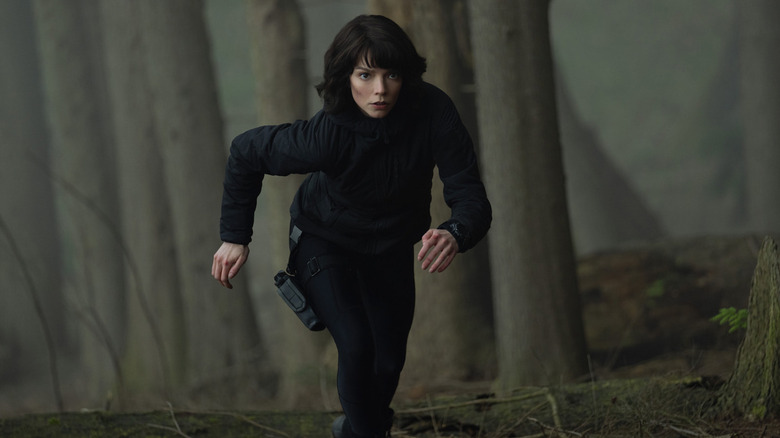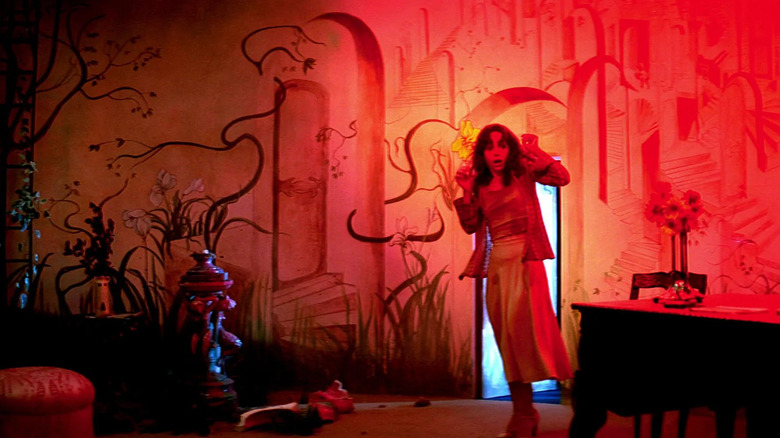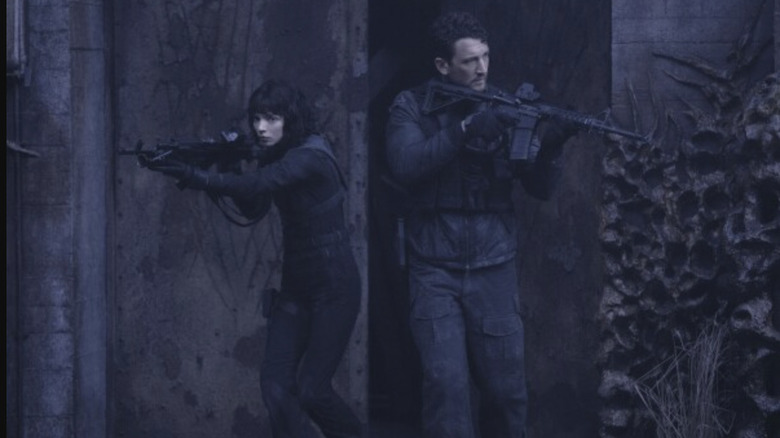The Unlikely Horror Classic That Inspired Scott Derrickson's The Gorge
It stands to reason that genre film lovers would make some of the best genre films. Of course, that's not a hard and fast rule — some fans-turned-filmmakers can become so blinded by their love of the movies that inspire them that they end up making a thinly veiled, watered-down version of what's come before. Yet when you're dealing with a filmmaker who has a keen creative sensibility and knows how to throw all their influences into a blender in order to come out with something that feels fresh yet familiar, then you're hitting that special sweet spot of genre cinema bliss.
Hitting that sweet spot is exactly what director Scott Derrickson has done with "The Gorge," a movie which is a veritable potpourri of genres, tones, and influences, all coming together in a way that's immensely satisfying. Derrickson has made a career out of proving his genre bonafides several times over, with movies like "Sinister," "Doctor Strange," and "The Black Phone" connecting with both genre fans and general audiences the hardest. Though he's delved into fantasy and science-fiction, Derrickson is most well known for his horror work. That's not incidental, as he's very clearly someone who adores the genre and is able to draw on his knowledge of it to lend his films some potent attributes.
In "The Gorge," Derrickson gets to let his genre freak flag fly once his two leads delve into the titular space, and the film goes wild with tons of visual imagination. Among the many influences that helped build the realm that lies within the gorge is an unlikely subset of horror (for American audiences, anyway): the Italian horror movies of the '70s and '80s, most notably Dario Argento's 1977 colorful masterpiece, "Suspiria." That subgenre and that film are big contributors to the way the world within the gorge looks, though they're not the only ones.
How Suspiria and Italian horror give The Gorge its look
"The Gorge," like the titular land formation, is a bifurcated movie. It begins as the story of two career snipers, Levi (Miles Teller), an ex-Marine, and Drasa (Anya Taylor-Joy), a Lithuanian mercenary, who are hired by their respective governments to travel to an undisclosed location where a giant gorge has been guarded by both Western and Eastern forces for nearly a century. Despite being told little about why this gorge needs to be guarded and why no contact can be formed with the sniper on the other side, the duo connect anyway, forming a bond deep enough that when Levi accidentally falls into the gorge, Drasa leaps in after him with no hesitation.
What begins as a romantic allegory for solitary, pandemic-related lockdown life and long-distance relationships quickly turns into a terrifying, action-packed adventure as Levi and Drasa encounter the creatures within the gorge, discover their relationship to the people who employed them, and work out how to escape while eliminating the threat to humanity that the place poses. For the first half of the film, Derrickson and cinematographer Dan Laustsen shoot the movie in a natural, handsome, yet muted palette, an aesthetic that recalls the work of Christopher Nolan and Joseph Kosinski. Once inside the gorge, however, the movie opens up literally and figuratively, as creepy creatures, bizarre environments, and bright colors fill the frame.
It's a bit of an "Alice in Wonderland" switch, or perhaps it's more apt to say "Snow White," the latter film being one of the influences on Argento while making "Suspiria." Argento was also a student and friend of the Italian genre maestro Mario Bava, whose work as a special effects technician eventually saw him make his own visually imaginative (and colorful) genre films like "Planet of the Vampires" and "Black Sabbath." It's the work of Argento and Bava that greatly inspired the color scheme of "The Gorge," as Derrickson told /FIlm's Jacob Hall:
"The look of it was very inspired by Italian horror cinema, the Bava and Argento, and the colored atmosphere, the audacity of the look of the colorful spaces. And for that not to just be there for aesthetic purposes, but it has a story relevance, why the different colors are what they are inside the gorge."
When asked about "Suspiria" specifically being an influence on "The Gorge," Derrickson confirmed but was quick to point out that he wasn't making a reference for reference's sake:
"That was very intentional. But again, I was only willing to do that if the presence of that color had reason for being there, which it does. And that's part of the unfolding mystery of what that place really is."
Indeed, so much of the story of what's really going on in "The Gorge" is told through these visual cues, so it's no wonder why Derrickson would turn to such a visually-rich subgenre as Italian horror.
The other horror influences within The Gorge
Keeping up a visual shorthand for the audience — who's being introduced to so many new environments and concepts deep into the second act of the film — is one reason why Derrickson drew upon a number of iconic elements and genre tropes in "The Gorge." In addition to Italian horror, the world within the gorge is heavily influenced by the granddaddy of all American genre films, 1933's "King Kong," as Levi and Drasa encounter a deluge of strange mutated beasties a la those found within Skull Island. (As a byproduct of this, the film also recalls both 2005's "King Kong" and 2017's "Kong: Skull Island," too.) When Levi and Drasa come upon a secret laboratory within the gorge and discover that it's full of creepy corpses and mysterious film reels left lying around, it feels like we're firmly in the survival horror video game world a la "Resident Evil" or "Dead Space."
One of the most intriguing influences on the aesthetics of "The Gorge" is that of folk horror. The experiment responsible for the film's "Hollow Men" (as Levi dubs them) involves human DNA being entwined with plants and animals, a plot point that allows for some truly unique and bizarre creatures to crop up in the movie. Derrickson elaborated on this influence, too:
"And also folk horror, the tradition of folk horror. There's so much old folklore and folk horror about plant people, stick people, animated trees, hybrids of that sort that have not been treated as a regular staple in horror cinema. And I thought that was an interesting direction to explore because it's not so familiar."
This influence allows "The Gorge" — which feels largely like a very American genre film — to have a further European flavor beyond the Italian horror. The folk horror elements harken back to films like Lawrence Gordon Clark's adaptation of M.R. James' "The Ash-tree," and extend all the way to David Lowery's recent film of "The Green Knight." They also allow for a good amount of body horror to be introduced into the movie, especially a bravura sequence in which Levi and Drasa have to make their way through a substance that's part people, part fungus (which, perhaps by accident, recalls 1993's "Super Mario Bros.").
As one can see, there is quite a lot more within "The Gorge" than initially meets the eye. As a celebration of genre, the film is ideal: it never feels derivative or lazy, yet it connects to so many classics that people new to horror can learn about while veteran fans can acknowledge and appreciate. This article is far from a complete summary of all the influences found in the film, so it must be said: There's still much to discover within "The Gorge."
Check out our full interview with Derrickson and screenwriter Zach Dean on today's episode of the /Film Daily podcast:
You can subscribe to /Film Daily on Apple Podcasts, Overcast, Spotify, or wherever you get your podcasts, and send your feedback, questions, comments, concerns, and mailbag topics to us at bpearson@slashfilm.com. Please leave your name and general geographic location in case we mention your e-mail on the air.


